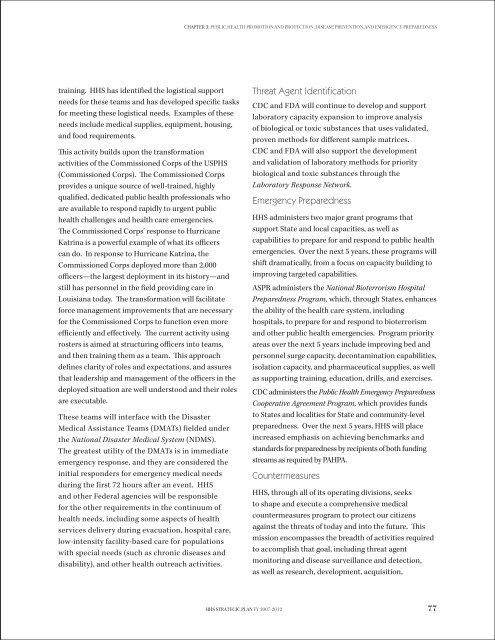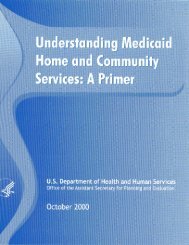STRATEGIC PLAN - ASPE - U.S. Department of Health and Human ...
STRATEGIC PLAN - ASPE - U.S. Department of Health and Human ...
STRATEGIC PLAN - ASPE - U.S. Department of Health and Human ...
You also want an ePaper? Increase the reach of your titles
YUMPU automatically turns print PDFs into web optimized ePapers that Google loves.
CHAPTER 3: Public <strong>Health</strong> Promotion <strong>and</strong> Protection, Disease Prevention,<strong>and</strong> Emergency Preparednesstraining. HHS has identified the logistical supportneeds for these teams <strong>and</strong> has developed specific tasksfor meeting these logistical needs. Examples <strong>of</strong> theseneeds include medical supplies, equipment, housing,<strong>and</strong> food requirements.This activity builds upon the transformationactivities <strong>of</strong> the Commissioned Corps <strong>of</strong> the USPHS(Commissioned Corps). The Commissioned Corpsprovides a unique source <strong>of</strong> well-trained, highlyqualified, dedicated public health pr<strong>of</strong>essionals whoare available to respond rapidly to urgent publichealth challenges <strong>and</strong> health care emergencies.The Commissioned Corps’ response to HurricaneKatrina is a powerful example <strong>of</strong> what its <strong>of</strong>ficerscan do. In response to Hurricane Katrina, theCommissioned Corps deployed more than 2,000<strong>of</strong>ficers—the largest deployment in its history—<strong>and</strong>still has personnel in the field providing care inLouisiana today. The transformation will facilitateforce management improvements that are necessaryfor the Commissioned Corps to function even moreefficiently <strong>and</strong> effectively. The current activity usingrosters is aimed at structuring <strong>of</strong>ficers into teams,<strong>and</strong> then training them as a team. This approachdefines clarity <strong>of</strong> roles <strong>and</strong> expectations, <strong>and</strong> assuresthat leadership <strong>and</strong> management <strong>of</strong> the <strong>of</strong>ficers in thedeployed situation are well understood <strong>and</strong> their rolesare executable.These teams will interface with the DisasterMedical Assistance Teams (DMATs) fielded underthe National Disaster Medical System (NDMS).The greatest utility <strong>of</strong> the DMATs is in immediateemergency response, <strong>and</strong> they are considered theinitial responders for emergency medical needsduring the first 72 hours after an event. HHS<strong>and</strong> other Federal agencies will be responsiblefor the other requirements in the continuum <strong>of</strong>health needs, including some aspects <strong>of</strong> healthservices delivery during evacuation, hospital care,low-intensity facility-based care for populationswith special needs (such as chronic diseases <strong>and</strong>disability), <strong>and</strong> other health outreach activities.Threat Agent IdentificationCDC <strong>and</strong> FDA will continue to develop <strong>and</strong> supportlaboratory capacity expansion to improve analysis<strong>of</strong> biological or toxic substances that uses validated,proven methods for different sample matrices.CDC <strong>and</strong> FDA will also support the development<strong>and</strong> validation <strong>of</strong> laboratory methods for prioritybiological <strong>and</strong> toxic substances through theLaboratory Response Network.Emergency PreparednessHHS administers two major grant programs thatsupport State <strong>and</strong> local capacities, as well ascapabilities to prepare for <strong>and</strong> respond to public healthemergencies. Over the next 5 years, these programs willshift dramatically, from a focus on capacity building toimproving targeted capabilities.ASPR administers the National Bioterrorism HospitalPreparedness Program, which, through States, enhancesthe ability <strong>of</strong> the health care system, includinghospitals, to prepare for <strong>and</strong> respond to bioterrorism<strong>and</strong> other public health emergencies. Program priorityareas over the next 5 years include improving bed <strong>and</strong>personnel surge capacity, decontamination capabilities,isolation capacity, <strong>and</strong> pharmaceutical supplies, as wellas supporting training, education, drills, <strong>and</strong> exercises.CDC administers the Public <strong>Health</strong> Emergency PreparednessCooperative Agreement Program, which provides fundsto States <strong>and</strong> localities for State <strong>and</strong> community-levelpreparedness. Over the next 5 years, HHS will placeincreased emphasis on achieving benchmarks <strong>and</strong>st<strong>and</strong>ards for preparedness by recipients <strong>of</strong> both fundingstreams as required by PAHPA.CountermeasuresHHS, through all <strong>of</strong> its operating divisions, seeksto shape <strong>and</strong> execute a comprehensive medicalcountermeasures program to protect our citizensagainst the threats <strong>of</strong> today <strong>and</strong> into the future. Thismission encompasses the breadth <strong>of</strong> activities requiredto accomplish that goal, including threat agentmonitoring <strong>and</strong> disease surveillance <strong>and</strong> detection,as well as research, development, acquisition,HHS Strategic Plan FY 2007-201277
















